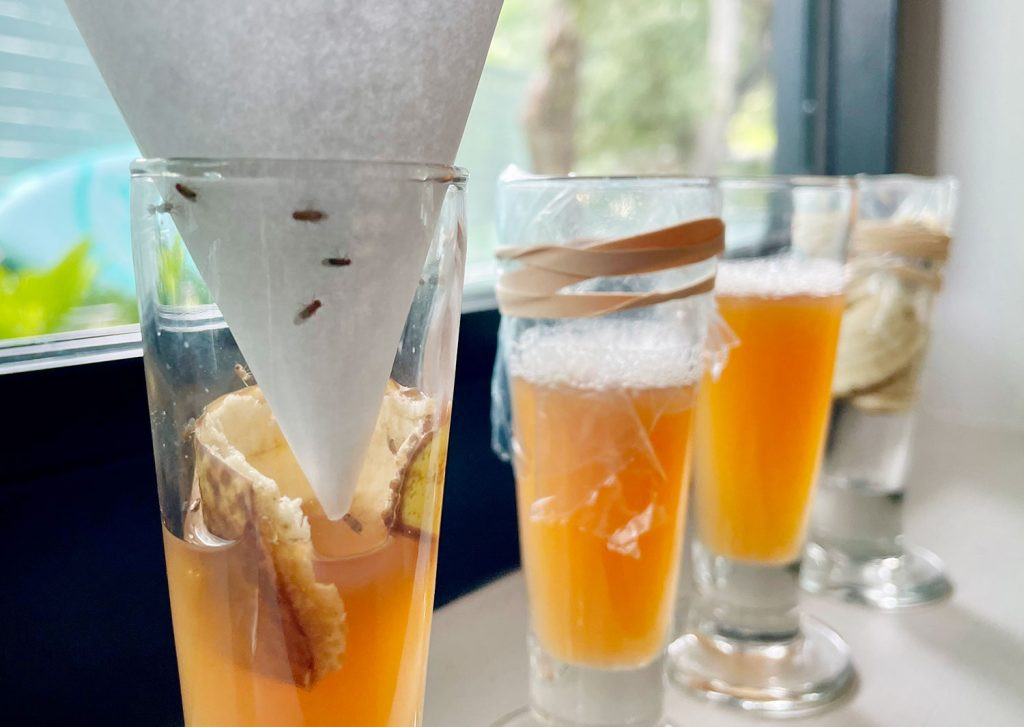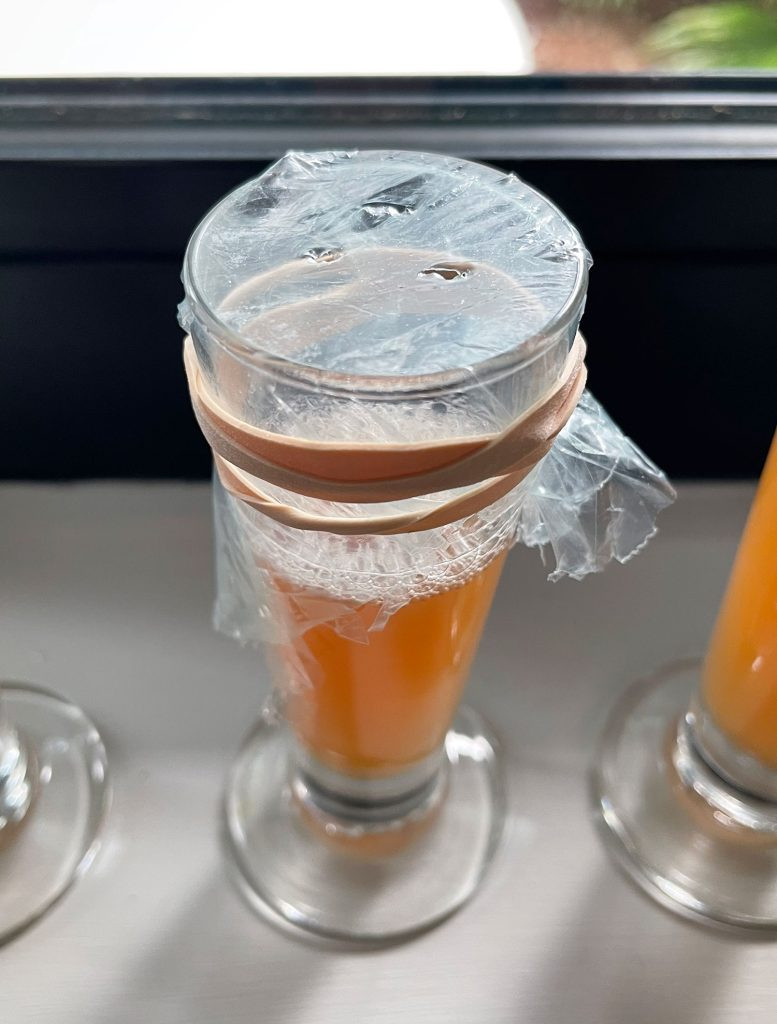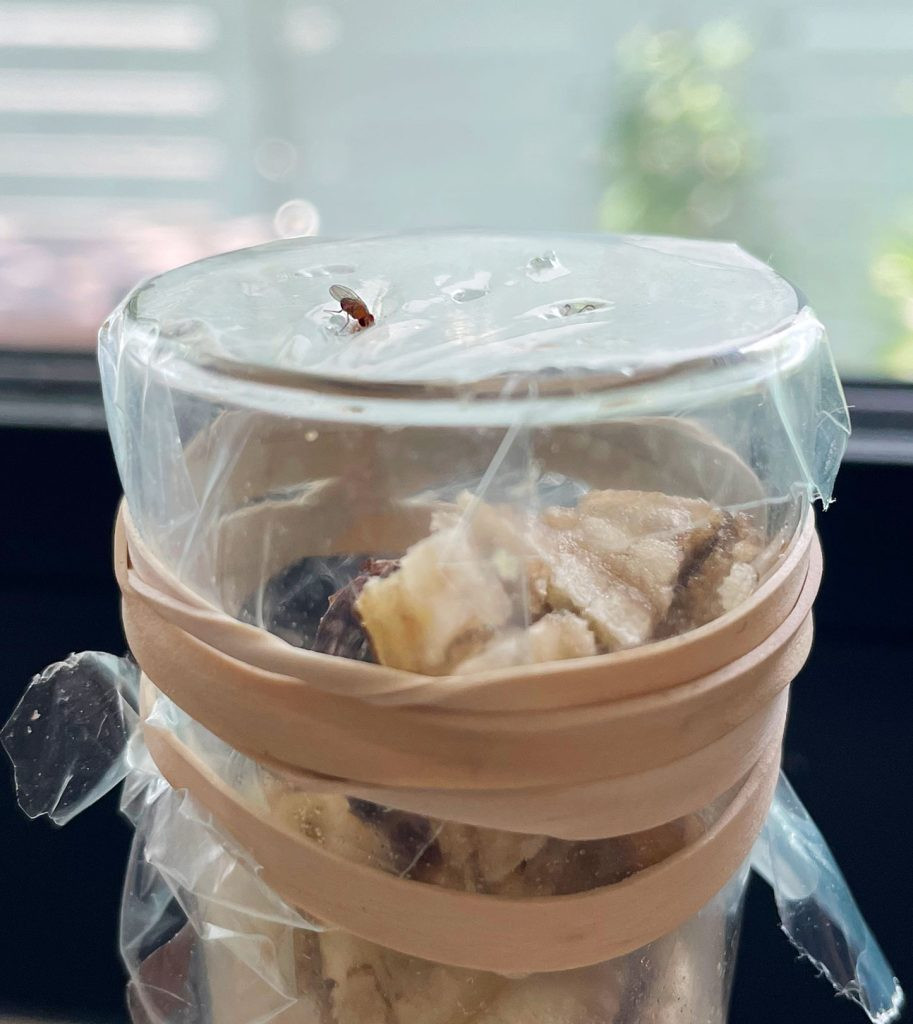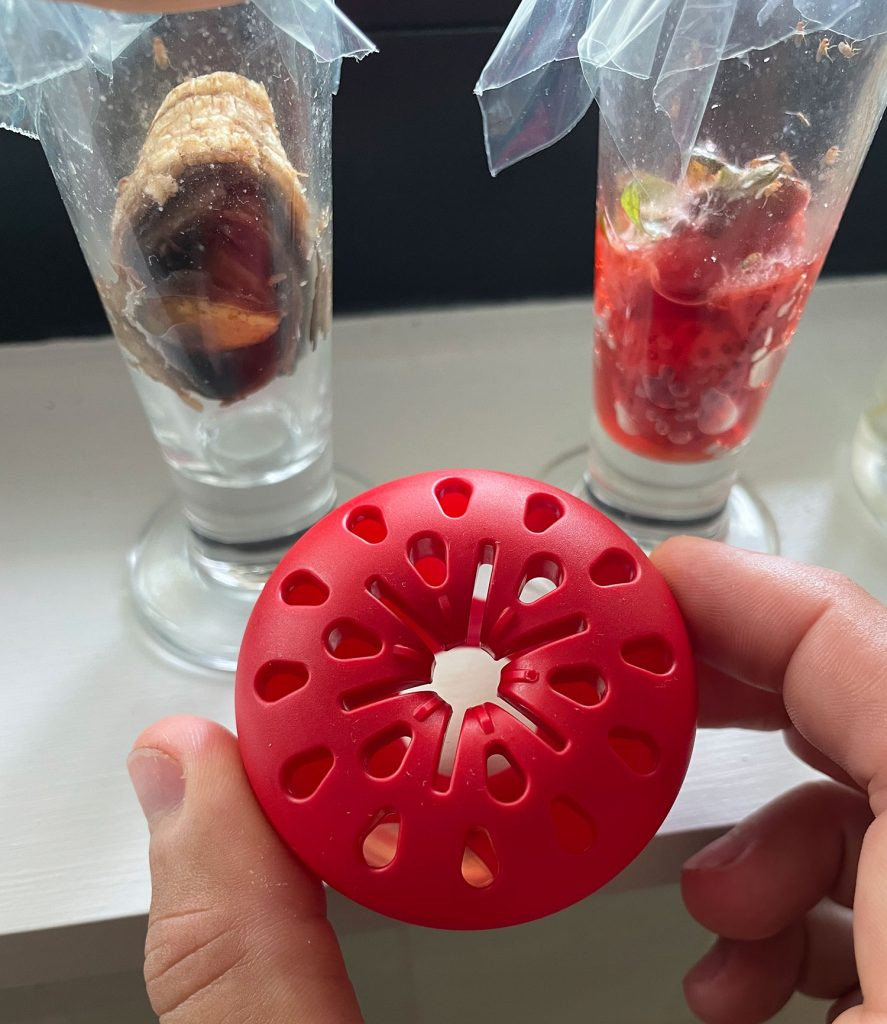Are you struggling with a fruit fly infestation in your home? Don’t worry, flyermedia.net is here to help you with effective solutions to eliminate these pesky insects. Understanding their behavior and employing the right strategies can make all the difference in reclaiming your kitchen and preventing future outbreaks. Let’s explore proven methods and insightful tips to keep your home fruit fly-free, and remember to visit flyermedia.net for more detailed guides on pest control, home maintenance, and a variety of DIY traps.
1. What Exactly Are Fruit Flies and Why Are They in My House?
Fruit flies are small, nuisance insects drawn to fermenting sugars found in fruits, vegetables, and other organic matter. These tiny pests are commonly found in kitchens, pantries, and areas where food is stored or prepared.
Fruit flies are attracted to your house by ripe or rotting fruits and vegetables, sugary spills, and even the residue in drains and garbage disposals. According to research from the University of California, Davis, fruit flies use their highly sensitive olfactory receptors to detect these food sources from a distance. Female fruit flies lay their eggs on the surface of fermenting food, and the larvae hatch within a day, quickly turning a small issue into a full-blown infestation. Understanding this attraction is the first step in effective fruit fly control.
2. What Are the Key Differences Between Fruit Flies, Fungus Gnats, and Drain Flies?
Distinguishing between fruit flies, fungus gnats, and drain flies is essential for implementing the correct eradication strategy. Here’s how to tell them apart:
| Feature | Fruit Flies | Fungus Gnats | Drain Flies |
|---|---|---|---|
| Appearance | Small, tan or brownish, red eyes | Small, dark, mosquito-like | Small, fuzzy, moth-like |
| Habitat | Near ripe/rotting fruits, sugary spills | Near houseplants, damp soil | Near drains, sewers, and moist areas |
| Breeding Sites | Overripe fruits, fermenting substances | Damp potting soil, decaying organic matter | Organic matter buildup in drains |
| Behavior | Hover around fruit, attracted to sweets | Fly weakly, often near soil surface | Fluttering flight, often seen on walls |
3. What Are the Best DIY Fruit Fly Trap Recipes to Use?
Creating your own fruit fly traps is an effective and budget-friendly way to tackle an infestation. Here are some of the best DIY recipes you can use at home:
3.1. How to Make a Funnel Trap
This method uses a funnel to trap fruit flies inside a container with bait. The narrow opening makes it difficult for the flies to escape.
- Supplies:
- Small jar or container
- Paper or cardstock
- Tape
- Scissors
- Apple cider vinegar (ACV) or wine
- Instructions:
- Pour ACV or wine into the container.
- Roll the paper into a cone shape, leaving a small opening at the bottom.
- Secure the cone with tape.
- Place the funnel into the jar, ensuring the tip doesn’t touch the liquid.
- Leave the trap near the fruit fly infestation.
 Fruit Flies Trapped In DIY Funnel Trap Method
Fruit Flies Trapped In DIY Funnel Trap Method
3.2. How to Create a Plastic Wrap Trap
This trap uses plastic wrap with tiny holes to lure fruit flies in, trapping them beneath the surface.
- Supplies:
- Small jar or container
- Plastic wrap
- Rubber band
- Toothpick
- Apple cider vinegar (ACV)
- Instructions:
- Pour ACV into the container.
- Cover the opening tightly with plastic wrap and secure with a rubber band.
- Poke small holes in the plastic wrap with a toothpick.
- Place the trap in an area with fruit fly activity.
 DIY Fruit Fly Trap With Apple Cider Vinegar And Plastic
DIY Fruit Fly Trap With Apple Cider Vinegar And Plastic
3.3. How to Use a Dish Soap Trap
Dish soap breaks the surface tension of the liquid, causing fruit flies to drown when they land on the bait.
- Supplies:
- Small bowl or dish
- Apple cider vinegar (ACV)
- Dish soap
- Instructions:
- Pour ACV into the bowl.
- Add a few drops of dish soap and gently mix.
- Place the bowl in an area with fruit fly activity.
3.4. How to Make a Rotting Fruit Trap
Using overripe fruit as bait can be highly effective, as it mimics the natural food source that attracts fruit flies.
- Supplies:
- Small jar or container
- Plastic wrap or paper funnel
- Overripe fruit (banana peel, apple slice)
- Instructions:
- Place the overripe fruit in the container.
- Cover the container with plastic wrap, securing it with a rubber band, and poke small holes. Alternatively, use a paper funnel.
- Position the trap where fruit flies are present.
 Fruit Fly Entering Plastic Wrap On DIY Trap
Fruit Fly Entering Plastic Wrap On DIY Trap
4. Which Bait Works Best for Attracting Fruit Flies to a Trap?
Choosing the right bait is crucial for the success of your fruit fly trap. Here’s a breakdown of what attracts fruit flies the most:
- Apple Cider Vinegar (ACV): A classic choice due to its fermented scent, which fruit flies find irresistible.
- Overripe Fruit: Banana peels, apple slices, and strawberries are particularly effective. Strawberries, as they rot, release a potent aroma that attracts fruit flies quickly.
- Wine or Beer: The alcohol and sugar content in these beverages make them highly attractive to fruit flies.
In a test conducted at flyermedia.net, traps baited with strawberries caught the most fruit flies, followed by banana peels. Apple cider vinegar also performed well, but not as effectively as the fruit baits. The key is to experiment and see what works best in your specific environment.
5. How Effective Are Store-Bought Fruit Fly Traps Compared to DIY Traps?
Store-bought fruit fly traps offer convenience and can be more discreet than DIY solutions. However, their effectiveness can vary.
- Pros of Store-Bought Traps:
- Convenient and ready to use
- Discreet design
- May contain specific attractants
- Cons of Store-Bought Traps:
- Can be more expensive
- May not be as effective as homemade traps with the right bait
According to a study by the Entomological Society of America, homemade traps using fruit baits often outperform commercial traps because they leverage the specific food preferences of local fruit fly populations. During tests conducted by flyermedia.net, DIY traps with fruit scraps caught more fruit flies initially compared to a store-bought trap. However, after a longer period, the store-bought trap did catch a significant number, indicating it works but may take more time.
 Terro Fruit Fly Apple Trap With No Fruit Flies In It
Terro Fruit Fly Apple Trap With No Fruit Flies In It
6. What Are the Essential Steps for Preventing Fruit Flies from Infesting My Home?
Preventing fruit flies from invading your home involves several key practices:
- Regular Cleaning: Wipe down kitchen surfaces, including counters, stovetops, and tables, to remove food residue and spills.
- Proper Waste Management: Take out the trash regularly to prevent food scraps from becoming breeding grounds.
- Fruit Storage: Dispose of overripe fruit promptly. Store fresh produce in the refrigerator to slow down ripening and prevent fruit flies from accessing it.
- Produce Washing: Wash fruits and vegetables as soon as you bring them home to remove any eggs or larvae.
- Drain Maintenance: Clean sink drains regularly to eliminate food scraps that attract fruit flies.
According to the Centers for Disease Control and Prevention (CDC), maintaining a clean and dry environment is the most effective way to prevent fruit fly infestations. Regular cleaning disrupts their breeding cycle and eliminates their food sources.
7. How Can I Eliminate Fruit Flies from My Sink Drains?
Fruit flies can breed in the moist, organic buildup inside sink drains. Here are effective methods to eliminate them:
- Boiling Water: Pour boiling water down the drain to kill larvae and remove organic matter.
- Vinegar and Baking Soda: Pour 1/2 cup of baking soda down the drain, followed by 1 cup of vinegar. Let it fizz for 30 minutes, then flush with hot water.
- Drain Cleaners: Use enzyme-based drain cleaners to break down organic buildup. Avoid harsh chemical cleaners, which can damage pipes and are less effective against fruit fly breeding sites.
- Regular Cleaning: Clean the drain regularly with a brush to remove buildup and prevent future infestations.
Research from Purdue University Extension recommends using a combination of these methods for best results. Regular maintenance prevents the accumulation of organic matter, making the drain less attractive to fruit flies.
8. Are There Any Natural Repellents That Keep Fruit Flies Away?
While traps are effective for catching fruit flies, natural repellents can help keep them away. Some options include:
- Essential Oils: Lavender, peppermint, and eucalyptus oils have repellent properties. Dilute a few drops in water and spray around the kitchen.
- Herbs: Place sprigs of basil, mint, or rosemary near fruit bowls and windows to deter fruit flies.
- Citrus Peels: Place orange or lemon peels around areas prone to fruit fly activity. The citrus scent repels them.
According to a study published in the Journal of Economic Entomology, essential oils like peppermint and eucalyptus are effective in repelling various insects, including fruit flies. Using these natural repellents in conjunction with traps can provide comprehensive fruit fly control.
9. How Quickly Can a Fruit Fly Infestation Escalate, and Why Is Timely Intervention Important?
Fruit flies have a rapid life cycle, which means a small issue can quickly become a significant infestation. Female fruit flies can lay hundreds of eggs at a time, and these eggs hatch within 24 to 30 hours. The larvae develop into adults in about a week, allowing populations to grow exponentially.
Timely intervention is crucial because:
- Rapid Reproduction: Fruit flies reproduce quickly, leading to rapid population growth.
- Contamination: They can contaminate food, spreading bacteria and pathogens.
- Nuisance: Large infestations are annoying and can impact your quality of life.
According to the World Health Organization (WHO), controlling insect populations, including fruit flies, is essential for preventing the spread of diseases and maintaining hygiene in food preparation areas.
10. What Are Some Advanced Strategies for Controlling Persistent Fruit Fly Infestations?
If you’re dealing with a persistent fruit fly infestation, consider these advanced strategies:
- Identify and Eliminate Breeding Sites: Thoroughly inspect your home for hidden breeding sites, such as garbage disposals, potted plants, and neglected spills.
- Professional Pest Control: If the infestation is severe, consult a professional pest control service. They can identify and treat breeding sites you might have missed.
- Insect Growth Regulators (IGRs): Use IGRs to disrupt the development of fruit fly larvae. These products are available in sprays and can be applied to potential breeding sites.
- Integrated Pest Management (IPM): Implement an IPM approach, combining multiple control methods to manage fruit flies effectively. This includes sanitation, trapping, and targeted insecticide use.
The Environmental Protection Agency (EPA) recommends using an IPM approach for effective and sustainable pest control. This strategy minimizes the use of pesticides and focuses on preventing infestations through sanitation and habitat modification.
By understanding fruit fly behavior and implementing these strategies, you can effectively eliminate and prevent fruit fly infestations in your home. Visit flyermedia.net for more information on pest control, home maintenance, and helpful DIY tips.
